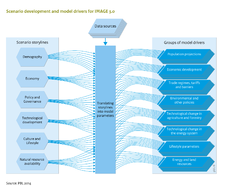Drivers/Scenario drivers: Difference between revisions
< Drivers
Jump to navigation
Jump to search
No edit summary |
No edit summary |
||
| Line 18: | Line 18: | ||
==Economics== | ==Economics== | ||
At the most aggregate level, the level of economic activity is typically described in terms of GDP (Gross Domestic Product) per capita. Models outside the IMAGE 3.0 framework estimate long-term GDP growth perspectives, following from development of the key production factors (e.g. capital, labour, natural resources) and the sectoral composition of the economy; such as the [[ENV-Growth model]] of the OECD. The overall GDP is composed of Value Added ( | At the most aggregate level, the level of economic activity is typically described in terms of GDP (Gross Domestic Product) per capita. Models outside the IMAGE 3.0 framework estimate long-term GDP growth perspectives, following from development of the key production factors (e.g. capital, labour, natural resources) and the sectoral composition of the economy; such as the [[ENV-Growth model]] of the OECD. The overall GDP is composed of Value Added (VA) per relevant sector and private consumption, estimated with more detailed models accounting for intersectoral linkages, responses to prices, and others ([[Chateau et al., 2013]]). Economic variables are used as model drivers for the [[energy demand]] model , and the non-agricultural water demand contributing to water stress (model component [[Hydrological cycle]]). For the household energy demand model, the average income is broken down into urban and rural population, and for each into quintiles of income levels. The latter is derived from the assumed, uneven income distribution by means of the so-called [[GINI coefficient|GINI factor]]. The GINI factor is a measure of income disparity in a population. If all enjoy the same income, GINI equals unity. The lower the GINI is, the wider is the gap between the lowest and highest income groups. The agricultural economy model [[MAGNET model|MAGNET]] is in fact an economy-wide Computable General Equilibrium (CGE) model, that is able to reproduce the exogenous GDP growth projections made with the less complex economic growth models; see model component [[Agricultural economy and forestry]] . The macro indicator GDP/capita is also used directly in various other IMAGE components, such as [[nutrient balances]] in urban wastewater, [[Human development|human health]], and [[flood risks]] . | ||
==Culture and lifestyle== | ==Culture and lifestyle== | ||
Revision as of 13:55, 12 February 2014
Parts of Drivers/Scenario drivers
| Projects/Applications |
| Models/Databases |
| Relevant overviews |
| Key publications |
| References |
